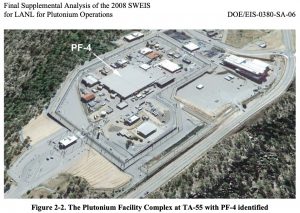
The National Nuclear Security Administration (NNSA) announced that it will NOT prepare a new site-wide environmental impact statement for the Los Alamos National Laboratory (LANL) (1). With this decision NNSA is slamming the door shut on public accountability while it rams through expanded plutonium “pit” bomb core production at the Lab. NNSA is relying upon outdated studies from 2008 to justify pit production. Since that time the agency has wasted billions of taxpayers’ dollars, another catastrophic wildfire threatened the Lab, serious deep groundwater contamination was discovered and LANL has had chronic nuclear safety incidences with plutonium that it can’t seem to fix.
In January 2020 our lawmakers were assured that public review of NNSA’s aggressive plans for expanded pit production required would be open. One media article reported:
“A review of a proposal to ramp up production of key components for the United States’ nuclear arsenal will be open and transparent, according to members of New Mexico’s congressional delegation. Sens. Tom Udall and Martin Heinrich and Rep. Ben Ray Lujan said in a joint statement to The Associated Press that they received assurances from federal officials that the review process also will include an opportunity for public comment.” (2)
The “reviews” that NNSA has completed, such as they are, were “Supplement Analyses” that are internal to the agency. They do not rise anywhere close to the level of environmental impact statements, much less the nation-wide programmatic environmental impact statement and LANL site-wide environmental impact statement that NukeWatch believes are legally required for expanded pit production under the National Environmental Policy Act. NNSA did offer the opportunity for public written comment on the Supplement Analyses, but that opportunity was not widely publicized, nor did NNSA hold public hearings as is required for environmental impact statements.
This is not the open and transparent process that our congressional delegation promised New Mexicans. This is particularly egregious given that expanded plutonium pit production is very expensive, environmentally damaging, puts public health and safety at risk and is fueling a new nuclear arms race.
Further, public review and comment is good for both the Lab and the public. Public comment on a 1999 LANL Site-Wide Environmental Impact Statement compelled LANL to undertake fire prevention measures around Area G, its largest waste dump that at the time was storing more than 40,000 barrels of radioactive wastes above ground. A year later the 2000 Cerro Grande Fire burned within a mile of Area G. It would have been catastrophic across northern New Mexico had those barrels ruptured and released wind-borne plutonium. (3)
Jay Coghlan of Nuclear Watch New Mexico commented, “It’s past time that our congressional delegation steps in and protects New Mexicans. They should demand that NNSA conduct current studies on expanded plutonium pit production with the opportunity for public comment and hearings as required by the National Environmental Policy Act.”
# # #
Endnotes
(1). NNSA’s Amended Record of Decision for the Site-Wide Environmental Impact Statement for the Continued Operation of Los Alamos National Laboratory, Los Alamos, NM is available at https://www.federalregister.gov/documents/2020/09/02/2020-19349/environmental-impact-statements-availability-etc-continued-operation-of-los-alamos-national
(2). Lawmakers assured review of nuclear weapons work to be open by Susan Montoya Bryan, January 22, 2020, https://apnews.com/5d500281694f4bbae30dc5356d18244d
(3). For LANL’s own praise after the Cerro Grande Fire of how public comment helped to reduce serious wildfire risk see https://hwbdocuments.env.nm.gov/Los%20Alamos%20National%20Labs/General/13435.pdf
It stated, “It is a story of an EIS process, of helpful public comments, of a timely response … then a great fire, called Cerro Grande, that proves the value of outsiders’ ideas… When the Cerro Grande Fire swept down from the mountains this spring, these extra defensive steps, taken in response to the public comments, paid for themselves many times over. The savings were in the form of the harm to facilities that was reduced or avoided and reduced risk to the public that might have resulted.”
This press release is available online at
